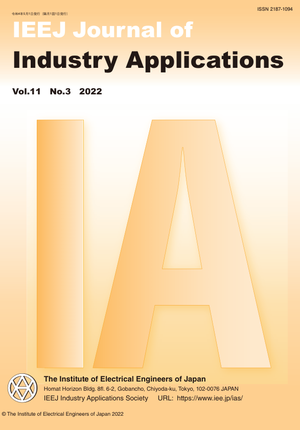Zero Moment Point Estimation Based on Resonant Frequencies of Wheel Joint for Wheel-Legged Mobile Robot
Zero Moment Point Estimation Based on Resonant Frequencies of Wheel Joint for Wheel-Legged Mobile Robot
カテゴリ: 論文誌(論文単位)
グループ名: 【D】産業応用部門(英文)
発行日: 2022/05/01
タイトル(英語): Zero Moment Point Estimation Based on Resonant Frequencies of Wheel Joint for Wheel-Legged Mobile Robot
著者名: Kenta Nagano (Department of Electrical Engineering, National Institute of Technology, Tokyo College), Yasutaka Fujimoto (Faculty of Engineering, Yokohama National University)
著者名(英語): Kenta Nagano (Department of Electrical Engineering, National Institute of Technology, Tokyo College), Yasutaka Fujimoto (Faculty of Engineering, Yokohama National University)
キーワード: wheel-legged mobile robot,zero moment point,resonant frequency,load estimation
要約(英語): The zero moment point (ZMP) is a measure for realizing dynamic motion in legged robots. An important concern in ZMP-based motion control is the measurement of the ZMP itself. General humanoid robots use sensors attached to their feet to measure the reaction forces. However, this method is not applicable for wheel-legged mobile robots because it is difficult to attach force sensors inside the wheels. Therefore, this study proposes a method to determine the ZMP based on the relationship between the load and resonant frequency of the tires. The resonant frequency of the tires depends on the tire pressure. First, the relationship between the load and resonant frequency is confirmed by a frequency analysis and experiments on the wheel joints. Second, a method used to estimate the ZMP based on the relationship between the load and resonant frequency is described. Third, an online estimation technique for the ZMP is described. Finally, factors other than the vertical force that affect the frequency characteristics of the wheel are discussed. The average of the root-mean-square errors from the sensor value in the online-ZMP estimation results is 0.0361 m, which is sufficiently smaller than the typical stability margin of the support polygon of the robot.
本誌: IEEJ Journal of Industry Applications Vol.11 No.3 (2022)
本誌掲載ページ: 408-418 p
原稿種別: 論文/英語
電子版へのリンク: https://www.jstage.jst.go.jp/article/ieejjia/11/3/11_21002314/_article/-char/ja/
受取状況を読み込めませんでした


